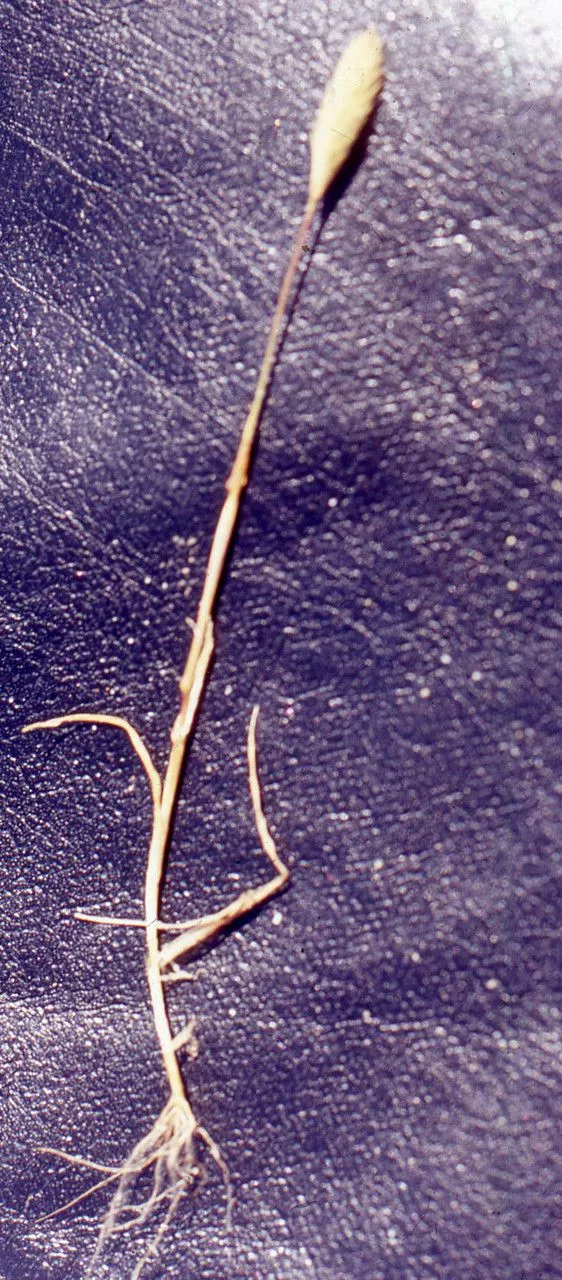
Author: L.
Bibliography: Sp. Pl.: 60 (1753)
Year: 1753
Status: accepted
Rank: species
Genus: Phleum
Vegetable: False
Observations: Europe to Medit.
The Sand cat’s-tail, known scientifically as Phleum arenarium, is a unique and fascinating plant belonging to the family Poaceae. Described initially by the renowned botanist Carl Linnaeus in his seminal work “Species Plantarum,” published in 1753, this plant has captured the interest of both botanists and nature enthusiasts.
Phleum arenarium is indigenous to a broad range extending from various parts of Europe to the Mediterranean region. This geographical distribution highlights its adaptability to different environmental conditions, particularly sandy soils and coastal habitats, where it commonly thrives. The plant’s ecological preference for sandy substrates is embedded in its common name, ‘Sand cat’s-tail,’ which aptly reflects its natural habitat.
The Sand cat’s-tail is a part of the grass family, Poaceae, which is one of the largest and most economically significant plant families globally. Grasses in this family are known for their simple leaves, hollow stems, and small, often inconspicuous flowers. However, what makes Phleum arenarium stand out is its distinctive appearance: the plant features slender, erect stems, and flower spikes that resemble the tail of a cat, hence the name.
Phleum arenarium’s flowering spikes, which emerge typically in the late spring to summer months, are densely packed with small florets. These spikes create an elegant and somewhat understated display that can be easily overlooked among more flamboyant floral species. Nevertheless, the slender, graceful stature of Sand cat’s-tail adds a subtle beauty to the sandy dunes and coastal regions it inhabits.
Furthermore, the plant plays an essential role in its ecosystem. The dense network of its roots helps stabilize sandy soils, preventing erosion and maintaining the integrity of coastal landscapes. This ecological function underscores the importance of Phleum arenarium in its native habitats, contributing to the health and sustainability of the environments it populates.
In summary, the Sand cat’s-tail or Phleum arenarium is a remarkable grass species integral to the biodiversity of European and Mediterranean sandy environments. Its understated elegance, ecological significance, and the rich botanical history, marked by Linnaeus’s early description, make it a noteworthy plant worthy of study and appreciation.
Fra: fléole des sables
Eng: sand timothy, sand cat’s-tail
Deu: sand-lieschgras, sandlieschgras
Dan: sand-rottehale
Nor: sandtimotei
Lit: smiltyninis motiejukas
Swe: hietatähkiö, sandtimotej, sandkampe
Fin: hietatähkiö
Nob: sandtimotei
Nno: sandtimotei
Lav: smiltaju timotinš
Nld: zanddoddegras, zanddoddengras
Cym: rhonwellt y gath ar dywod, rhonwellt y tywyn
Gla: tiomóid duimhche
En: Sand cat’s-tail, Sand timothy
Da: Sand-rottehale
Nl: Zanddoddegras, Zanddoddengras
Fi: Hietatähkiö
Fr: Fléole des sables, Phléole des sables
De: Sand-Lieschgras (Sandlieschgras), Sand-Lieschgras, Sandlieschgras
It: Codolina delle spiagge
Lv: Smiltaju timotinš
Lt: Smiltyninis motiejukas
No: Sandtimotei
Nb: Sandtimotei
Nn: Sandtimotei
Gd: Tiomóid duimhche
Sv: Sandtimotej, Hietatähkiö, Sandkampe
Cy: Rhonwellt y Gath ar Dywod, Rhonwellt y Tywyn
© copyright of the Board of Trustees of the Royal Botanic Gardens, Kew.
Taken Jan 17, 2020 by Awad Younes (cc-by-sa)
Taken Jun 11, 2006 by Tela Botanica − Julien BARATAUD (cc-by-sa)
Taken Aug 8, 2019 by Paul Lm (cc-by-sa)
Taken Jun 11, 2006 by Tela Botanica − Julien BARATAUD (cc-by-sa)
Taken Jul 1, 2010 by Alain Lagrave (cc-by-sa)
Taken Jun 5, 2018 by Ineke Kuijs (cc-by-sa)
Taken May 2, 2020 by C. Susana (cc-by-sa)
Taken May 15, 2006 by Photoflora – Jean-Luc TASSET (©)
Taken Apr 28, 2022 by Isabelle LE DUC (cc-by-sa)
Taken Jan 17, 2020 by Awad Younes (cc-by-sa)
Taken May 15, 2021 by Simon Brumby (cc-by-sa)
Taken May 1, 2019 by norbert verneau (cc-by-sa)
Taken May 22, 2022 by Christian Wasser (cc-by-sa)
Taken Jun 18, 2022 by Jona Lumo (cc-by-sa)
Taken Jun 28, 2008 by Tela Botanica − Mathieu MENAND (cc-by-sa)
Taken Jun 6, 2013 by Tela Botanica − Geneviève Botti (cc-by-sa)
Taken May 17, 2004 by Tela Botanica − Liliane Roubaudi (cc-by-sa)
Taken May 17, 2004 by Tela Botanica − Liliane Roubaudi (cc-by-sa)
Taken Jun 27, 2013 by Tela Botanica − Florent Beck (cc-by-sa)
Taken Jun 27, 2013 by Tela Botanica − Florent Beck (cc-by-sa)
Taken May 31, 1877 by Tela Botanica − Herbier PONTARLIER-MARICHAL (cc-by-sa)
Taken May 29, 1903 by Tela Botanica − Anne-Marie GRIMAUD (cc-by-sa)
Taken May 31, 1869 by Tela Botanica − Herbier PONTARLIER-MARICHAL (cc-by-sa)
Taken Jun 6, 2013 by Tela Botanica − Liliane Roubaudi (cc-by-sa)
Taken Jun 6, 2013 by Tela Botanica − Liliane Roubaudi (cc-by-sa)
Growth habit: Graminoid
Family: Myrtaceae Author: (F.Muell.) K.D.Hill & L.A.S.Johnson Bibliography: Telopea 6: 402 (1995) Year: 1995 Status:…
Family: Rubiaceae Author: Pierre ex A.Froehner Bibliography: Notizbl. Bot. Gart. Berlin-Dahlem 1: 237 (1897) Year:…
Family: Sapindaceae Author: Koidz. Bibliography: J. Coll. Sci. Imp. Univ. Tokyo 32(1): 38 (1911) Year:…
Family: Asteraceae Author: A.Gray Bibliography: Pacif. Railr. Rep.: 107 (1857) Year: 1857 Status: accepted Rank:…
Family: Fabaceae Author: Medik. Bibliography: Vorles. Churpfälz. Phys.-Ökon. Ges. 2: 398 (1787) Year: 1787 Status:…
Family: Aspleniaceae Author: (Cav.) Alston Bibliography: Bull. Misc. Inform. Kew 1932: 309 (1932) Year: 1932…